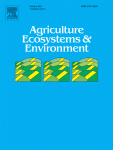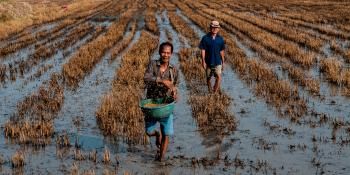Whole-farm greenhouse gas emission balances and hotspots quantified in smallholder coffee-dairy systems in Central Kenya

Understanding how agricultural management practices impact productivity, greenhouse gas emissions, and carbon sequestration throughout the farm is critical to developing climate-smart agriculture options.
In Central Kenya, decreasing farm sizes have increased intensification in dairy farming, but it is unknown how the changing practices impact the whole-farm greenhouse gas (GHG) balance.
Researchers from the University of Copenhagen, the Centre de Coopération Internationale en Recherche pour le Développement (CIRAD), Institut de Recherche pour le Développement (IRD), and the World Agroforestry Centre (ICRAF), with support from mutliple institutions including CCAFS, analyzed data from 125 farming households in Murang'a County and published the results in Farm-scale greenhouse gas balances, hotspots and uncertainties in smallholder crop-livestock systems in Central Kenya in Agriculture Ecosystems and Environment.
Using the Cool Farm Tool, they found farms to be a net source of greenhouse gas emissions. The following image, Figure 1 from the journal article, shows how typical farm-scale livelihood activities contribute to GHG emissions and carbon (C) sequestration in the integrated smallholder crop-livestock system found in Central Kenya . Numbers 1–5 represent typical farm components: (1) livestock, (2) manure management systems, (3) soil, (4) crops and (5) trees. Letters a–e are where carbon and nitrogen are released or absorbed: (a) fodder, crop residues and concentrates, (b) dung, urine and bedding materials, (c) inorganic fertiliser, manure and crop residues, (d) nitrogen uptake by crops, (e) the biomass harvested that can follow different pathways: livestock feed, compost heap or mulch.
Though emissions varied according to farm type, researchers found that livestock enteric fermentation followed by manure management systems and soil emissions are emission hotspots. In diversified farming systems found in the study area, farmers need to take holistic approaches to identify mitigation options since there are many interactions among farm activities and strategies that influence each other. The researchers point out use of crop residues as an example of complexity, noting that GHG trade-offs between crop residues use as soil amendment, fuel, composting or livestock feeding are still understudied.
Analyses provided evidence for two practices that can tip the balance toward low emissions development: manure management and agroforestry.
With some support from climate initiatives, researchers suggest, smallholder farmers in Central Kenya could mitigate climate change.
Read the article:
Ortiz-Gonazalo D, Vaast P, Oelofse M, de Neergard A, Albrecht A, Rosenstock TS. 2017. Farm-scale greenhouse gas balances, hotspots and uncertainties in smallholder crop-livestock systems in Central Kenya. Agriculture, Ecoystems and Environment 248:58-70.
Read more about the article in an ICRAF blog:
Vaast P, Rosenstock TS. 017. Greenhouse gases and climate-smart options in Central Kenya.
Read more about agricultural greenhouse gas quantification:
Standard Assessment of Agricultural Mitigation Potentials and Livelihoods project: SAMPLES
Julianna White is Program Manager for CCAFS Low Emissions Development research.




